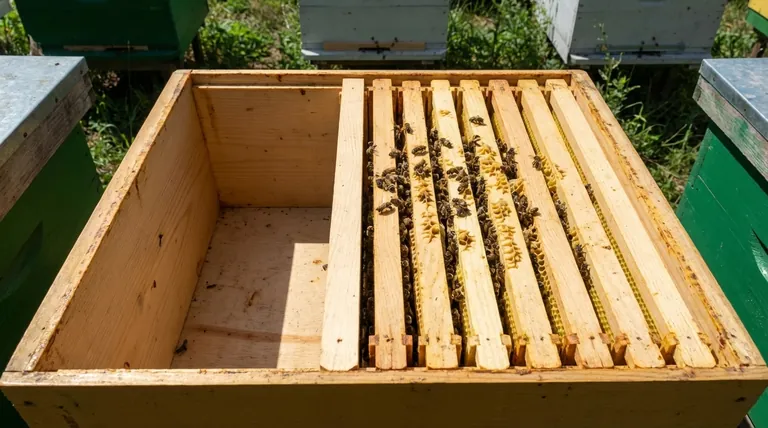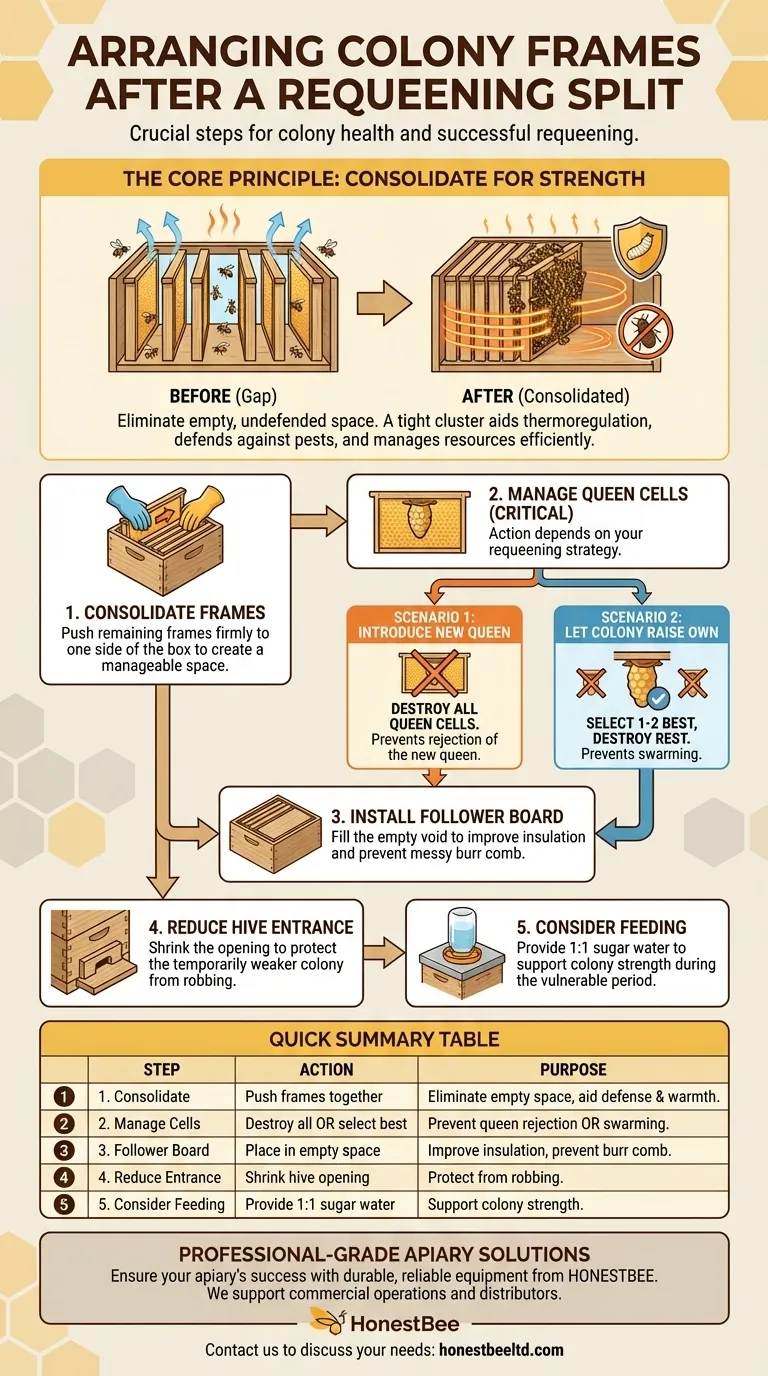After removing frames to create a nuc for requeening, the remaining frames in the original, full-size colony should be pushed firmly together to one side of the hive box. This consolidation is a critical step that creates a more manageable and defensible space for the remaining bee population.
The core principle is to eliminate empty, undefended space within the hive. Consolidating the frames helps the now queenless colony maintain temperature, defend against pests, and manage its resources efficiently as it prepares to accept or raise a new queen.

The Rationale Behind Consolidation
When you remove several frames from a strong colony, you leave a significant void. Simply leaving this gap is detrimental to the colony's health and organization.
Why Tightly Packed Frames Matter
A beehive's primary challenge is thermoregulation, or maintaining the brood nest at a stable temperature (around 95°F or 35°C).
A tight cluster of bees on consolidated frames can manage this efficiently. A large, empty space forces the bees to expend far more energy to prevent heat loss, stressing the colony.
Aiding Pest and Disease Management
Pests like wax moths and small hive beetles thrive in empty, undefended comb.
By pushing all frames together, you create a compact cluster that the bees can patrol and defend effectively, minimizing opportunities for pests to establish themselves.
Creating Clear, Usable Space
Consolidating frames to one side creates a single, contiguous empty area on the other side.
This makes it easy to add a follower board (or division board), which effectively shrinks the interior volume of the hive to match the colony's reduced size.
A Critical Step: Managing Queen Cells
Before you rearrange the frames, you must address any remaining queen cells. Your action here depends entirely on your requeening strategy. The reference to "remove any remaining queen cells" is only true in one specific scenario.
Scenario 1: Introducing a New Mated Queen
If your plan is to introduce a new, purchased queen to the original hive, you must meticulously destroy every single queen cell.
If even one queen cell remains, the workers will likely reject and kill the new queen you are trying to introduce, preferring to raise their own.
Scenario 2: Letting the Colony Raise Its Own Queen
If your goal is a "walk-away split," where you intend for the original colony to raise its own queen from the cells left behind, you would do the opposite.
In this case, you should select one or two of the largest, best-looking queen cells and destroy the rest to prevent the colony from swarming with the first virgin queen that emerges.
Best Practices and Common Pitfalls
Properly arranging the frames is more than just closing a gap. A few extra steps ensure the colony's success during this vulnerable period.
Use a Follower Board
A follower board is essentially a thin board, the same size as a frame, used to fill the empty space after you consolidate the frames.
This prevents the bees from building messy burr comb in the gap and improves the hive's insulation, further aiding thermoregulation.
Reduce the Hive Entrance
A colony that has just been split is weaker and temporarily queenless, making it a prime target for robbing by stronger hives.
Using an entrance reducer to shrink the hive opening makes it much easier for the guard bees to defend their home.
Consider Feeding the Colony
The process of raising a new queen and the associated break in the brood cycle can be stressful.
Providing a 1:1 sugar water solution can give the bees the resources they need to build up their strength and support the new queen once she begins laying.
Making the Right Choice for Your Goal
Your actions immediately after the split should directly support your specific requeening plan for the original hive.
- If your primary focus is introducing a new, mated queen: Your priority is to destroy all queen cells, consolidate the remaining frames against one wall, and add a follower board to create a tight, secure space for the new queen.
- If your primary focus is letting the colony raise its own queen: Your priority is to select the best one or two queen cells, destroy the rest, consolidate the frames, and provide support through a reduced entrance and potential feeding.
Properly managing the space in your hive is the key to ensuring both your new nuc and your original colony thrive through the requeening process.
Summary Table:
| Step | Action | Purpose |
|---|---|---|
| 1. Consolidate Frames | Push remaining frames firmly together to one side of the box. | Eliminates empty space, aids thermoregulation and defense. |
| 2. Manage Queen Cells | Destroy all cells for a new queen; select best 1-2 for a self-raised queen. | Prevents queen rejection or swarming. |
| 3. Use a Follower Board | Place a board in the empty space created by consolidation. | Improves insulation and prevents burr comb. |
| 4. Reduce Entrance | Use an entrance reducer to shrink the hive opening. | Protects the weaker colony from robbing. |
| 5. Consider Feeding | Provide a 1:1 sugar water solution. | Supports colony strength during the vulnerable period. |
Ensure your apiary's success with professional-grade equipment. Proper hive management is fundamental, and having the right tools makes all the difference. HONESTBEE supplies commercial apiaries and beekeeping equipment distributors with the durable, reliable supplies needed for critical operations like requeening. From hive boxes and frames to essential tools, our wholesale-focused operations are designed to support your business's growth and efficiency.
Contact HONESTBEE today to discuss your equipment needs and discover how we can help your operation thrive.
Visual Guide

Related Products
- Assembled Wooden Bee Frames with Beeswax Foundation Ready to Use by HONESTBEE
- HONESTBEE Wired and Assembled Wooden Bee Frames Foundation for a Thriving Hive
- Heavy-Duty Stainless Steel Clip-On Frame Perch
- Professional In-Hive Bee Feeder HONESTBEE Frame for Beekeeping
- Heavy-Duty Stainless Steel Frame Grip
People Also Ask
- What are the main parts of a hive frame? A Guide to Modern Hive Anatomy
- Can I reuse old frames? A practical guide to saving money and reducing waste
- What are the advantages of using wooden beehive frames? Natural, Sustainable, and Bee-Friendly
- When should I throw away my bee frame? A Guide to Hive Health & Frame Rotation
- Can old bee frames be reused? Weighing the Risks vs. Rewards for Your Hive



















